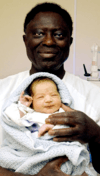Lactation suppression
Lactation suppression refers to the act of suppressing lactation by medication or other non pharmaceutical means. The breasts may become painful when engorged with milk if breastfeeding is ceased abruptly, or if never started. This may occur if a woman never initiates breastfeeding, or if she is weaning from breastfeeding abruptly. Historically women who did not plan to breastfeed were given diethylstilbestrol and other medications after birth to suppress lactation. However, its use was discontinued, and there are no medications currently approved for lactation suppression in the US and the UK.
Reasons
After birth, some women may desire to stop the production of breast milk, for example when the mother decides to bottle feed from birth, or in the case when the infant dies[1] or is surrendered at birth. Additionally, women who are breastfeeding may need to stop breastfeeding abruptly, for instance if she is taking medication contradicted for breastfeeding or undergoes surgery. The abrupt weaning process may lead to severe engorgement, extremely painful breasts, and possibly mastitis. Up to one third of women who do not breast-feed and who use a brassiere or binder, ice packs, or analgesics may experience severe breast pain. Specific studies of nonpharmacologic methods of lactation suppression were limited and inconclusive. Available data suggest that many women using currently recommended strategies for treatment of symptoms may nevertheless experience engorgement or pain for most of the first postpartum week.
Methods
Medication
Cabergoline (Dostinex™) is currently most effective option currently available, as it is available as a single dose (as opposed to bromocriptine which must be taken twice daily for 2 weeks.)[2] It may be prescribed in the case of breast abscess. Although the preferred method of treatment for breast abscess and mastitis is actually to continue breastfeeding, if the decision is made to stop breastfeeding, then chemical lactation suppression is indicated, particularly for severe cases. Carbergoline is not indicated for treatment of discomfort caused by engorgement.[2]
In the past, hormonal therapies, such as diethylstilbestrol and bromocriptine were routinely used in the postpartum period, but these are no longer recommended due to side effects as they alter hormone levels dramatically and cause side effects such as nausea and vomiting,[2] and severe potential side effects such as thromboembolism, cerebral accident, and myocardial infarction (DES is also a known carcinogen).
Estrogen containing birth control pills may have the same side effect. Pseudoephedrine may also suppress lactation, as it is known to cause low supply.[3]
In the US. Spitz et al.[4] in a 100-year review of all available information concluded that there was nothing new or helpful to assist with the mammary involution or milk suppression process or to treat the pain or discomfort of severely engorged breasts.
Other methods
By simply not stimulating the breasts after birth, after a few days the production of milk will decease. If breastfeeding has already been established, the production of milk typically takes longer to decrease and may take several weeks. Women may experience pain and discomfort from engorgement. This discomfort is may be relieved by hand-expressing milk or the use of a pump to reduce engorgement and prevent mastitis.[5] The discomfort can also be treated with analgesics. However, as much as one third of all women will experience severe pain in this process.
Historically, binding the breasts by use of tight-fitting bras or ace bandages was used, but this is now discouraged as this may cause blocked milk ducts and mastitis.[2] Fluid restriction is also not recommended as it is likely ineffective and unnecessary.[6]
Cabbage leaves are a common recommendation to reduce discomfort from engorgement. However, a Cochrane review of three studies on this subject concluded that there was no statistically significant evidence that interventions were associated with a more rapid resolution of symptoms; in these studies women tended to have improvements in pain and other symptoms over time whether or not they received active treatment.[7]
According to the Cochrane review other interventions such as hot/cold packs, Gua-Sha (scraping therapy), acupuncture, and proteolytic enzymes may be promising for the treatment of breast engorgement, but there is insufficient evidence to justify widespread implementation.[7]
See also
References
- ↑ Moore DB, Catlin A (2003). "Lactation suppression: forgotten aspect of care for the mother of a dying child" (PDF). Pediatric Nursing. 29 (5): 383–4. PMID 14651312.
- 1 2 3 4 Kataria K, Srivastava A, Dhar A (December 2013). "Management of lactational mastitis and breast abscesses: review of current knowledge and practice". The Indian Journal of Surgery. 75 (6): 430–5. doi:10.1007/s12262-012-0776-1. PMC 3900741. PMID 24465097.
- ↑ Aljazaf K, Hale TW, Ilett KF, Hartmann PE, Mitoulas LR, Kristensen JH, Hackett LP (July 2003). "Pseudoephedrine: effects on milk production in women and estimation of infant exposure via breastmilk". British Journal of Clinical Pharmacology. 56 (1): 18–24. doi:10.1046/j.1365-2125.2003.01822.x. PMC 1884328. PMID 12848771.
- ↑ Spitz AM, Lee NC, Peterson HB (December 1998). "Treatment for lactation suppression: little progress in one hundred years". American Journal of Obstetrics and Gynecology. 179 (6 Pt 1): 1485–90. doi:10.1016/s0002-9378(98)70013-4. PMID 9855585.
- ↑ Smith LJ (1998). "Guidelines For Rapid Reduction of Milk Supply". BFLRC Ltd. Retrieved 2018-03-24.
- ↑ Swift K, Janke J (2003). "Breast binding... is it all that it's wrapped up to be?". Journal of Obstetric, Gynecologic, and Neonatal Nursing: JOGNN. 32 (3): 332–9. doi:10.1177/0884217503253531. PMID 12774875.
- 1 2 Mangesi L, Zakarija-Grkovic I (June 2016). "Treatments for breast engorgement during lactation". The Cochrane Database of Systematic Reviews (6): CD006946. doi:10.1002/14651858.CD006946.pub3. PMID 27351423.
